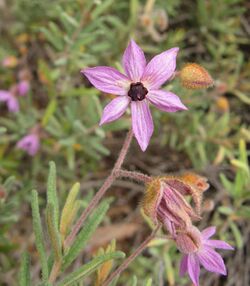Biology:Lysiosepalum involucratum
| Lysiosepalum involucratum | |
|---|---|

| |
| Scientific classification | |
| Kingdom: | Plantae |
| Clade: | Tracheophytes |
| Clade: | Angiosperms |
| Clade: | Eudicots |
| Clade: | Rosids |
| Order: | Malvales |
| Family: | Malvaceae |
| Genus: | Lysiosepalum |
| Species: | L. involucratum
|
| Binomial name | |
| Lysiosepalum involucratum (Turcz.) Druce[1]
| |
| Synonyms | |
| |
Lysiosepalum involucratum is a small shrub species in the family Malvaceae. It is endemic to the south-west of Western Australia.[2] Plants grow to between 0.3 and 1.5 metres high, and produce mauve flowers between August and November in the species' native range.
The species was first formally described as Thomasia involucrata by botanist Nicolai Stepanovitch Turczaninow in 1852 in Bulletin de la Société Impériale des Naturalistes de Moscou. The species was transferred to the genus Lysiosepalum in 1917 by English botanist George Claridge Druce.[1]
Cultivation
The species prefers a sunny or partially shaded position in well-drained soil. Established plants tolerate dry periods The most common method of propagation is from cuttings of semi-mature new growth. Although plants may be propagated from seed, it is difficult to obtain.[3]
References
- ↑ 1.0 1.1 "Lysiosepalum involucratum". Australian Plant Name Index (APNI), IBIS database. Centre for Plant Biodiversity Research, Australian Government, Canberra. http://www.anbg.gov.au/cgi-bin/apni?TAXON_NAME=Lysiosepalum+involucratum. Retrieved 21 August 2011.
- ↑ "Lysiosepalum involucratum". FloraBase. Western Australian Government Department of Parks and Wildlife. https://florabase.dpaw.wa.gov.au/browse/profile/5049.
- ↑ "Lysiosepalum involucratum". Australian Native Plants Society (Australia). http://anpsa.org.au/l-inv.html. Retrieved 21 August 2011.
Wikidata ☰ Q12061419 entry

